Legal for Feed Deer in Kansas
GENERAL BIG GAME INFORMATION
- Big game and turkey permits purchased during the open season are valid immediately after purchase.
- Deer hunters may purchase only one permit that allows the harvest of an antlered deer.
- Permits are not transferable.
- Shooting hours for big game are 1/2 hour before sunrise to 1/2 hour after sunset.
LICENSE REQUIREMENTS
All individuals, regardless of land ownership and age, must possess valid permits or tags to hunt big game or turkeys. In addition, a valid Kansas hunting license is required unless exempt by Kansas law (See "License Exemptions" on Page 6). There is no minimum age to hunt big game. Permits and tags may restrict hunting to specific species and unit(s) or zone boundaries listed on the permit. Consult boundary maps included in this brochure before hunting.
HUNT-OWN-LAND PERMITS
These permits shall be valid only on lands owned or lands leased for agricultural purposes. See Page 17 for complete definitions of who qualifies for these permits.
REPLACEMENT PERMITS
No individual shall copy, reproduce, or possess any hard copy or reproduction of a big game or wild turkey permit or carcass tag. Hunters may possess e-licenses, e-permits and e-tags on a mobile device. In the event of loss or theft, replacement big game permits and turkey permits may be obtained from any KDWPT office, license agent for the fee of$2.50. Duplicate permits may be obtained online at no charge. If you harvest any big game or turkey that is not edible, a replacement permit will not be issued.
REFUNDS
Permit refunds can be issued for the following reasons: (1) death of the applicant prior to the season of use; (2) unknowing duplication of specific issue (does not include duplication contrary to law or regulation); (3) permit issued in error by the department; (4) armed forces personnel experiencing a change of duty station prior to the first day of season, preventing use of the permit; and (5) by direction of a court order or at the direction of a prosecuting attorney. Permit refunds will not be granted once the legal season for that permit has opened.
BIG GAME AND TURKEY
Deer and elk taken with an antlerless-only permit must be transported with the visible sex organs naturally attached to the carcass or a quartered portion of the carcass, and turkeys taken during the spring season must be transported with the beard attached.
However, for hunters who want to bone out the meat in the field, use an e-tag or the voluntary option that allows hunters to register their harvested deer, elk or spring turkey through the Internet, using photos taken at the harvest site, then transport without evidence of sex. This is not a telephone check system, and it is not required unless you want to transport your deer or elk taken with an antlerless only permit without the head attached or a spring turkey without the beard attached to the breast. Once a hunter has photographs necessary for registration later or a confirmation number obtained over the Internet, the hunter may then transport the carcass without evidence of sex attached. For complete directions on this process, go online to ksout-doors.com and click "Hunting/Big Game/Deer/Deer Check-in."
ASSISTANCE TO BIG GAME PERMIT HOLDERS
A Kansas hunting license is required (unless exempt by Kansas law) to herd or drive big game and wild turkeys for a permit holder. Any person with a permanent physical or visual disability that prevents the person from hunting safely, as certified by a physician, may be eligible to obtain a permit to designate someone else to take a legal limit of game for the permit holder. A permit holder who is, because of disability, unable to pursue a wounded game animal may designate any individual to assist in pursuing and dispatching an animal wounded by the disabled permit holder. For more information, or for a disabled assistance application, contact the KDWPT Pratt Operations Office, (620) 672-5911, and ask for Law Enforcement.
ANTLERLESS-ONLY HUNTERS
Hunters must have a deer permit that allows the taking of an antlered deer before acquiring an antlerless deer permit. However, after Dec. 30, an antlered permit is no longer required to purchase antlerless permits, which are avail-able over-the-counter through Jan. 31, 2023.
BLINDS AND STANDS ON PUBLIC LANDS AND WIHA
Blinds and stands may be used on department lands, subject to posted requirements and under the following conditions: (1) stands may not be placed more than 14 days prior to the season and shall be removed within 14 days of the close of the season; (2) ladders, screw-in metal steps, and steps attached by ropes, cables, or chains may be used to access stands and must be removed with the stand;(3) natural blinds may be used and shall be constructed of natural herbaceous materials or woody debris present on site; (4) any person may use these stands if not occupied; (5) only two portable blinds or stands per department-owned or managed area are allowed per hunter; (6) portable blinds and stands must be marked with the owner's name and address or KDWPT number; (7) portable blinds may not be left unattended overnight; and (8) any stand not conforming to the requirements may be removed or destroyed by department staff.
LOCATING BIG GAME ANIMALS WITH DOGS
Dogs may be used to locate dead or wounded big game animals with the following restrictions: each dog shall be maintained on a hand-held leash at all times; an individual tracking big game animals outside of legal shooting hours shall not carry equipment capable of harvesting the big game animal; and each individual harvesting a big game animal shall be limited to the equipment type for the permit and season that is authorized. Each individual participating in the tracking of a big game animal shall have a hunting license, unless the individual is exempt by law. To find individuals with trained blood tracking dogs, go to <a href="http://www.unitedbloodtrackers.org.
MILITARY INFORMATION
Smoky Hill ANG Range
Hunting on Smoky Hill ANG Range is open only to military and retired military personnel who have attended a training class and who possess a deer permit valid in Unit 4.
Fort Riley
Hunters with valid unit permits must possess a limited access permit to hunt on Fort Riley. For season dates, fact sheets and more, call (785) 239-6211 or visit www.fortriley.isportsman.net. Fort Riley military reservation or portions of it may be closed at any time, without prior notice, due to military activities. The military mission has precedence over the announced hunting seasons. All hunters are required to register their firearms prior to hunting on the military reservation, and are required to check-in/out.
Fort Leavenworth
Deer hunting at Fort Leavenworth is open only to military and retired military personnel who have attended a training class and who possess a deer permit valid in Unit 10. For more information, contact the post hunting coordinator at (913) 684-1703.
Fort Leavenworth military installation, which is adjacent to the Unit 19 deer unit boundary, has been declared an urban deer unit. Unit 19 deer season dates apply to hunters hunting on the military installation. As many as five Antlerless-only Whitetail Deer permits for Unit 10A may be purchased for use on Fort Leavenworth.
LEGAL EQUIPMENT
Firearm permit holders may hunt with any legal equipment during the firearm season. Muzzleloader permit holders may only hunt with muzzleloading or archery equipment during the muzzleloader and firearm seasons. Archery permit holders may only use archery equipment during the archery season, even during days that overlap the muzzleloader or regular firearm season.
FIREARMS
Legal firearms include centerfire rifles and handguns that are not fully automatic, using only hard-cast solid lead, soft point, hollow point, tumble-on-impact, or other expanding bullets; any gauge shotgun using only slugs.
MUZZLELOADERS
Legal muzzleloaders include rifles, pistols or muskets that can be loaded only through the front of the firing chamber with separate components and that fire a bullet of .40 inches in diameter or larger, using hard-cast solid lead, conical lead, saboted, or tumble-on-impact bullets.
ARCHERY
Legal archery equipment includes long-bows, recurve bows, compound bows and crossbows. No bow, crossbow or arrow may have any electronic device attached that controls the flight of the arrow. Devices that may be attached to a bow or arrow shall include lighted pin, dot or holographic sights; illuminated nocks; rangefinders; film or video cameras; radio-frequency location devices; and draw-lock devices. Arrows used for hunting big game must be equipped with broadhead points that when fully expanded cannot pass through a ring 3/4-inch in diameter. Non-broadhead arrows may be possessed while hunting but may not be used to take big game. Devices capable of dispensing chemicals may not be used.
ACCESSORY EQUIPMENT
Lures, decoys and non-electric calls may be used while hunting big game. Hunters may use blinds and stands. Range-finding devices and optical scopes or sights that project no visible light toward the target and do not electronically amplify visible or infrared light may be used. Horses and mules shall not be used for herding or driving big game. Firearm report-suppression devices may be used with proper permits. Handguns may be possessed during all big game seasons. However, only handguns specified as legal equipment for firearms or muzzleloader seasons may be used for big game hunting.
Ethical hunters select equipment most effective for their capabilities, the game they hunt and the style of hunting they prefer. Hunters should consider muzzle velocity, kinetic energy, bullet type, recoil and accuracy when selecting equipment that is adequate for the game hunted.
PERMIT CLASSES
GENERAL RESIDENT
A resident is defined as any person who has continuously lived in Kansas for 60 days immediately preceding the person's application for a hunting license or permit. Members of the armed services on active duty who were Kansas residents at the time of entering the service, and immediate family members living with them, are considered residents regardless of duty station. Members of the armed services on active duty and officially stationed in Kansas may purchase resident licenses and permits, except for lifetime licenses. Any holder of a Kansas lifetime hunting license who has moved from the state may apply for permits as a resident. Any person who is a registered full-time student in residence at a public or private secondary, post secondary, or vocational school located in Kansas may purchase resident licenses and permits, except lifetime licenses. While hunting, the student must carry evidence of being a full-time student residing in Kansas.
LANDOWNER/TENANT
A landowner is any resident who owns 80 acres or more of Kansas farm or ranch land. When applying for a landowner/tenant permit, land owned must be in the unit applying for.
A tenant is any resident or nonresident who is actively engaged in the agricultural operation of 80 acres or more of Kansas farm or ranch land for the purpose of producing agricultural commodities or livestock and (A) has a substantial financial investment in the production of agricultural commodities or livestock on such farm or ranch land and the potential to realize substantial financial benefit from such production or, (B) is a bona fide manager having an overall responsibility to direct, supervise and conduct such agricultural operation and have the potential to realize substantial benefit from such production in the form of salary, shares of such production or some other economic incentive based upon such production. Evidence of tenancy, if requested, shall be provided to the department and may include, but is not limited to, Natural Resource Conservation Service records, Farm Service Agency records, or written agricultural contract or lease documentation. Land must be in the unit applied for to qualify.
Members of the immediate family who are domiciled with a resident landowner or tenant may apply for a resident big game permit as landowners or as a tenants, but at least 80 acres must be owned by such landowner or operated by such tenant for each individual applying as a landowner or as a tenant.
HUNT-ON-YOUR-OWN-LAND
Hunt-On-Your-Own-Land permits are valid for either species during any season with equipment legal for that season, and only on lands owned and operated for agricultural purposes. This permit is available to individuals who qualify as landowners, tenants, nonresident landowners or family members living with a resident landowner or tenant.
NONRESIDENT LANDOWNER
To qualify as a nonresident landowner, a person must own farm or ranch land in simple ownership with their name on the deed. Property held in a trust, LLC, partnership, or other legal entity is owned by that legal entity. Permits on properties owned by a legal entity are available only to tenants who either farm at least 80 acres, or manage an 80 acre or larger farm that produces an agricultural commodity such as crops or cattle. Serving as a board member, trustee, non managing partner or other such position does not qualify a person for a Kansas landowner deer permit. For details, phone (620) 672-5911 and ask for Law Enforcement.
NONRESIDENT
Anyone who doesn't qualify in the definitions above.
YOUTH
Resident and nonresident youth who are 15 and younger qualify for reduced price youth big game permits.
Special hunt-own-land deer permits may be issued to a resident landowner's or tenant's siblings and lineal ascendants or descendants, and their spouses, whether or not a Kansas resident. Evidence of ownership or tenancy, and sibling or lineal ascending or descending relationship, if requested, shall be provided to the department.
DEER
KANSAS DEER MANAGEMENT
Harvesting female deer is the most effective way to control deer where deer numbers exceed people's tolerance due to damages or disturbances they may cause. Hunting may also be used to control deer problems and maintain a population that habitat supports.
Deer adapt to hunting pressure and find areas where they can evade hunters. In some cases, those areas are created because a particular landowner desires to restrict or prohibit hunter access. Protected areas serve as refuges and may result in future herd increases and higher deer damage on adjacent or other properties where protected deer spend time when hunting season is closed.
Landowners have several options for controlling deer on their property: 1) allow or increase hunting; 2) encourage hunters to harvest antlerless deer; 3) contact KDWPT at (620) 672-5911 for the hunter referral list; or 4) apply for deer control permits that may be used when damage occurs while normal hunting seasons are closed.
DEER MANAGEMENT UNITS
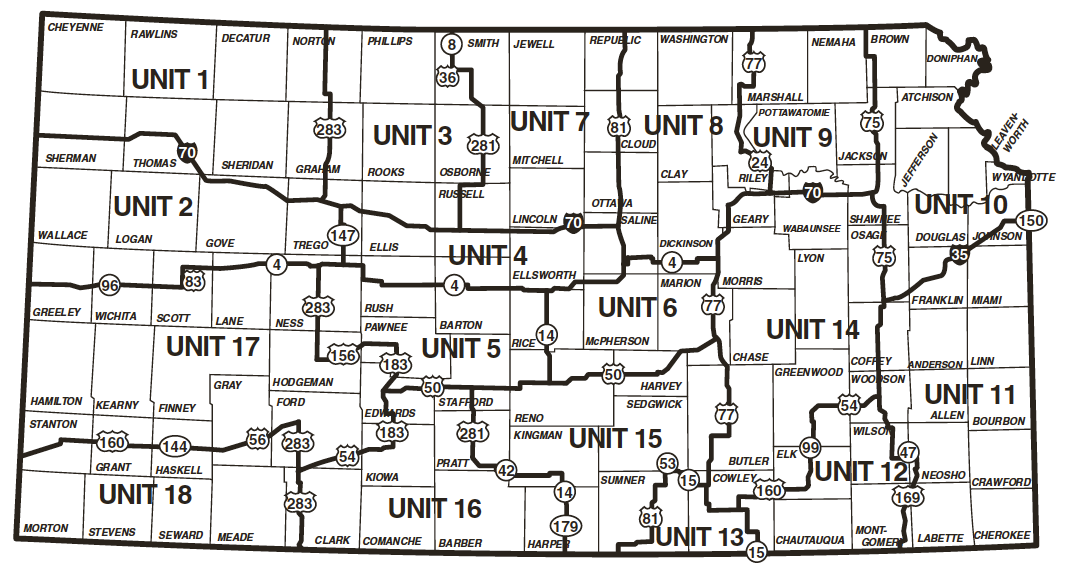

LEGAL DEFINITIONS
White-tailed Either-sex Deer: any buck, doe, or fawn white-tailed deer.
Either-species/Either-sex Deer: any buck, doe, or fawn white-tailed or mule deer.
Antlerless-Only White-tailed Deer: any white-tailed deer without a visible antler plainly protruding from the skull.
Antlerless-only Deer: any white-tailed or mule deer without a visible antler plainly protruding from the skull.
SEASONS
Youth/Disabled Season: Sept. 3-11, 2022
Muzzleloader Season: Sept. 12-25, 2022
Archery Season: Sept. 12-Dec. 31, 2022
Pre-rut Whitetail Antlerless Firearm Season: Oct. 8-10, 2022
Regular Firearm Season: Nov. 30-Dec. 11, 2022
Extended Firearm Whitetail Antlerless-only Season: Jan. 1-8, 2023 Units 6, 8, 9, 10, 17
Extended Firearm Whitetail Antlerless-only Season: Jan. 1-15, 2023 Units 1, 2, 3, 4, 5, 7, 11, 14 and 16
Special Extended Firearm Whitetail Antlerless-only Season: Jan. 1-22, 2023 Units 10A, 12, 13, 15 and 19
Extended Archery Whitetail Antlerless-only Season: Jan. 23-31, 2023 Units 19 and 10A
APPLICATIONS (RESIDENT/NONRESIDENT)
Resident Firearm Either-Species/Either-Sex permits and nonresi-dent antlered permits are available through online application only. The application includes a $10 nonrefundable application fee for res-idents and $25 nonrefundable application fee for nonresidents. Unsuccessful applicants will earn a preference point for the following year's draw. The application deadline for Resident Firearm Either-species/Either-sex permits is June 9, 2023. The application deadline for nonresident antlered permits is April 28, 2023.
MILITARY BASE DEER SEASONS
Fort Leavenworth Firearm: Nov. 12-13, Nov. 19-20, Nov. 24-27, Dec. 3-4, and Dec. 10-11, 2022
Fort Leavenworth Extended Firearm: Jan. 1-22, 2023
Fort Leavenworth Extended Archery: Jan. 23-31, 2023
Smoky Hill Air National Guard Subunit Firearm: Nov. 30-Dec. 11, 2022
Fort Riley Firearm: Nov. 25-27, Dec. 17-23, Dec. 26-27, 2022
Fort Riley Archery: Sept. 12-Dec. 31, 2022 and by special authorization Sept. 1-11, 2022 and Jan. 1-31, 2023
Fort Riley Youth/Disabled: Sept. 3-11, 2022, and by special authorization Oct. 8-10, 2022
Shooting Hours: One-half hour before sunrise to 1/2 hour after sunset.
SEASON DESCRIPTIONS
YOUTH AND DISABLED (Sept. 3-11)
Youth 16 and younger, who possess a valid deer permit, may hunt during this special firearm deer season — using equipment listed on permit — only while under the immediate supervision of an adult 18 or older. Any person who possesses a valid deer permit and has a permit to hunt from a vehicle pursuant to KAR 115-18-4 or a disability assistance permit issued pursuant to KAR 115-18-15 may also hunt during this season. All resident and nonresident permits are valid, and equipment restrictions designated on permits apply. Hunter orange required.
MUZZLELOADER (Sept. 12-25)
The following permits may be used during this season in units specified on permit, using muzzleloader or archery equipment: resident or non-resident Muzzleloader Either-species/Either-sex permit, resident Any-Season White-tailed Deer permit, nonresident Muzzleloader White-tailed Deer permit, Hunt-Own-Land permit, Special Hunt-Own-Land permit, and Whitetail Antlerless Only Deer permit. Hunter orange required.
ARCHERY (Sept. 12-Dec. 31)
The following permits may be used during this season in units specified on permit, using archery equipment only: resident or nonresident Archery Either-species/Either-sex permit, resident Any-Season White-tailed Deer permit, nonresident Archery White-tailed Deer permit, Hunt-Own-Land permit, Special Hunt-Own-Land permit, and Whitetail Antlerless-only permit. Resident archery Either-species/Either-sex permits are valid statewide; nonresident archery permits are valid in up to two deer management units listed on permit. Unfilled 2022 permits may be used in the DMU 19 extended archery season for antlerless whitetails. Hunter orange clothing is required during dates of open muzzleloader and firearm deer seasons.
PRE-RUT FIREARM WHITETAIL ANTLERLESS (Oct. 8-10))
Any permit that allows the harvest of a white-tailed antlerless deer is valid during this season. Equipment and unit restrictions on permit imposed. Hunter orange clothing is required.
REGULAR FIREARM (Nov. 30-Dec. 11)
The following permits may be used during this season in units specified on permit: resident or nonresident Muzzleloader Either-species/Either-sex permit (muzzleloader, archery equipment), nonresident Muzzleloader White-tailed Deer permit (muzzleloading, archery equipment only), resident Any-Season White-tailed Deer permit (statewide), nonresi-dent Firearm White-tailed Deer permit, Hunt-Own-Land permit, Special Hunt-Own-Land permit, and Whitetail Antlerless Only permit. Hunter orange clothing is required. (The archery season remains open, but archery permit holders may only hunt with archery equipment and must wear hunter orange.)
EITHER-SPECIES/ EITHER-SEX ZONES (RESIDENT)
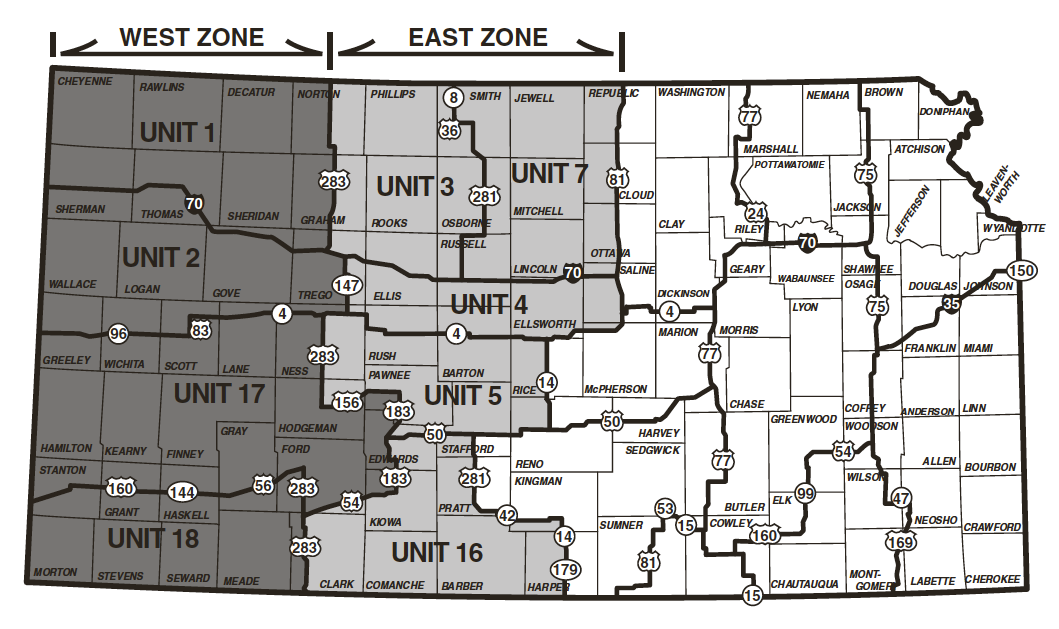
URBAN DEER MANAGEMENT UNITS 19 & 10A
Urban deer management units were created to focus greater deer harvest in the Kansas City-to-Topeka corridor. Unit 19 will host an extended archery season (Jan. 23-31, 2023).
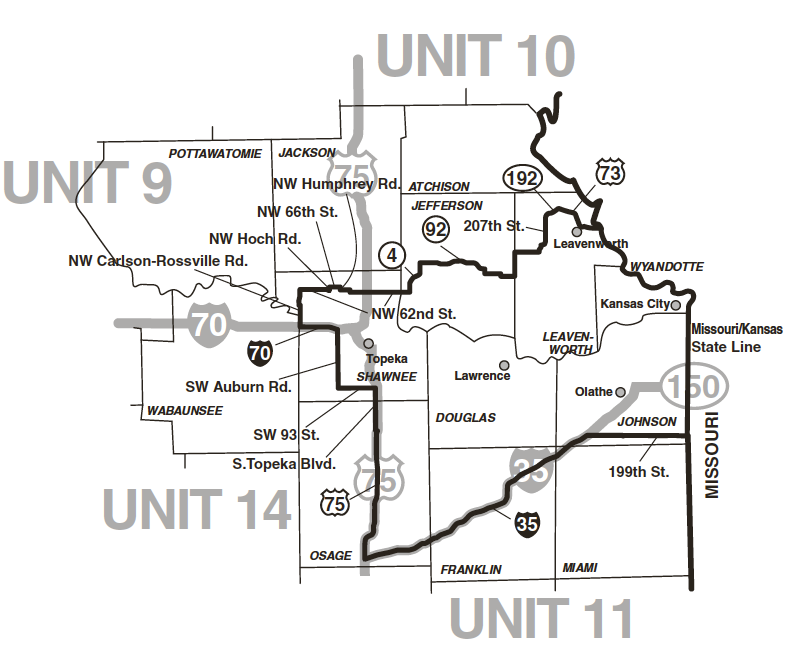
Unit 10A is Fort Leavenworth and is open to active and retired military staff only.
All properties owned or managed by KDWPT, except WIHA areas, are excluded from Unit 19. These properties are open only under their original unit. For example, Clinton Wildlife Area and Douglas State Fishing Lake are open only during Unit 10 seasons.
WHO MAY HUNT IN UNIT 19
- Unit 9, 10, 11, and 14 permit holders, with permit season and equipment restrictions.
- Archery permit holders during the regular archery season; the Extended Firearm Whitetail Antlerless-only season, Jan. 1-22, 2023; and the Extended Archery Whitetail Antlerless-only season, Jan. 23-31, 2023. Hunter orange is required of all deer hunters during any firearm sea-son. State-owned and state-managed lands, excluding WIHA, are not included in Unit 19.
- Holders of Hunt-Own-Land permits valid in Unit 19, during any season with legal equipment.
- Holders of Whitetail Antlerless-only permits, during any season with legal equipment.
- Holders of Any-season/Either-sex Whitetail permits, during any season with legal equipment.
WHITETAIL ANTLERLESS ONLY UNITS
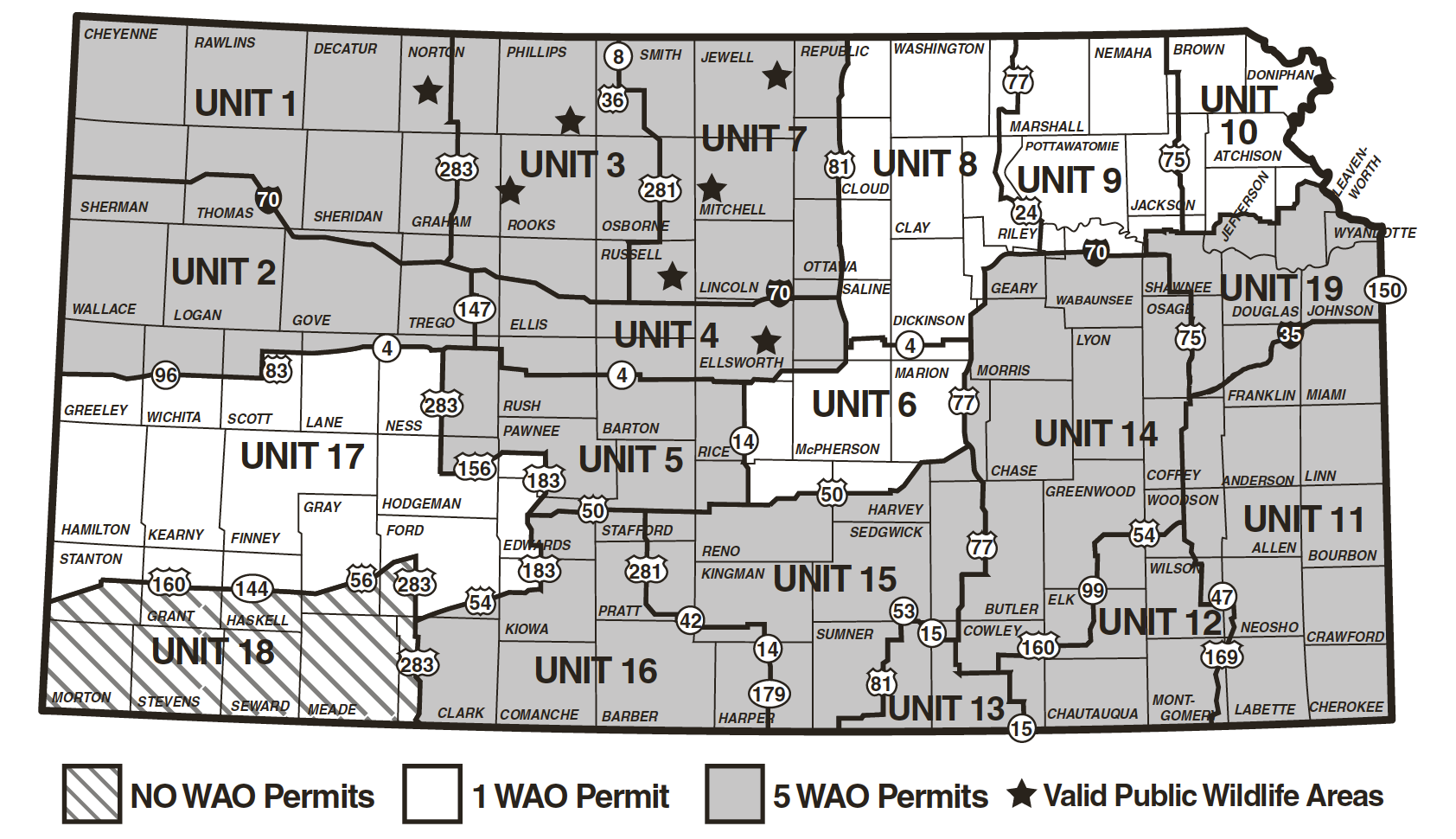
EXTENDED WHITETAIL ANTLERLESS ONLY (WAO) SEASONS
EXTENDED FIREARM WHITETAIL ANTLERLESS ONLY
Jan. 1-8, 2023 (DMU 6, 8, 9, 10, and 17)
Jan. 1-15, 2023 (DMU 1, 2, 3, 4, 5, 7, 11, 14 and 16)
Jan. 1-22, 2023 (DMU 10A, 12, 13, 15 and 19)
Any unfilled 2022 deer permit valid in units open may be used dur-ing the extended whitetail antlerless-only seasons. Resident Either-species/Either-sex permits valid for the East or West zones are valid for an antlerless white-tailed deer only in units listed on the permit.
Any legal equipment may be used to take a white-tailed deer without a visible antler plainly protruding from its skull during the extended season. A valid Kansas hunting license is required, unless exempt by Kansas law. Hunter orange clothing is required.
EXTENDED ARCHERY WHITETAIL ANTLERLESS ONLY
(DMU 10A and 19) (Jan. 23-31, 2023)
The following unfilled permits are valid during this season using archery equipment only for antlerless whitetails. Resident and nonresident Archery Either-species/Either-sex permit, nonresident Archery White-tailed Deer permit, resident Any-Season White-tailed Deer permit, Hunt-Own-Land Permit valid within units 19 and 10A, Special Hunt-Own-Land permit valid within units 19 and 10A, and Whitetail Antlerless Only Deer permit. A valid hunting license is required, unless exempt by Kansas law. Unit 10A is Ft. Leavenworth and is open only to active and retired military staff.
The first Whitetail Antlerless Only permit purchased is valid statewide except DMU 18, including all public lands and WIHA. Up to four additional Whitetail Antlerless Only permits may be purchased and are valid in the units shaded above on private land with permission, WIHA and the public wildlife areas designated with stars.
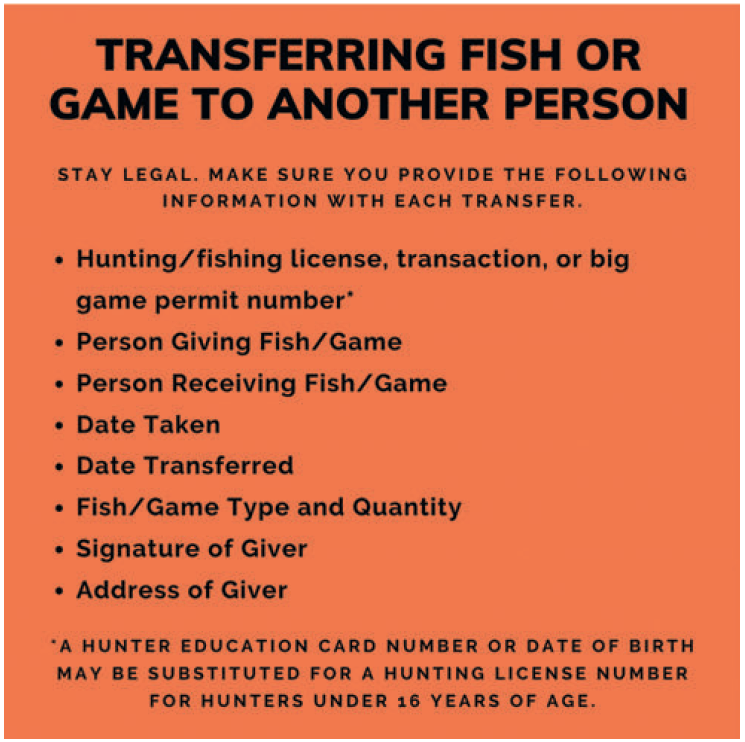
PERMIT DESCRIPTIONS (Hunting restricted to units listed on permits.)
RESIDENT ANY-SEASON WHITE-TAILED DEER
Bag limit: One (1) buck, doe, or fawn white-tailed deer
Any-season White-tailed Deer permits are valid statewide in any season with equipment legal for that season. Available over the counter through Dec. 30 to residents and landowner/tenants only.
RESIDENT FIREARM EITHER-SPECIES/EITHER-SEX (application online only)
Bag limit: One (1) buck, doe, or fawn white-tailed or mule deer
FFirearm Either-species/Either-sex Deer permits are valid either in the West Zone or in the East Zone (see map on Page 19) during the regular firearm season using any legal equipment. Available to resi-dents and landowner/tenants by draw only (deadline to apply is June 9, 2023).
RESIDENT MUZZLELOADER EITHER-SPECIES/EITHER-SEX
Bag limit: One (1) buck, doe, or fawn white-tailed or mule deer
Muzzleloader Either-species/Either-sex Deer permits are valid either in the West Zone or in the East Zone during the muzzleloader-only and regular firearm seasons using muzzleloading or archery equipment. Available over the counter through Dec. 30 to residents and landowner/tenants only.
RESIDENT ARCHERY EITHER-SPECIES/EITHER-SEX
Bag limit: One (1) buck, doe, or fawn white-tailed or mule deer
Resident Archery Either-species/Either-sex Deer permits are valid statewide with archery equipment during archery season. Available over the counter through Dec. 30 to residents and landowner/tenants only.
NONRESIDENT MUZZLELOADER WHITE-TAILED DEER COMBO (application online only)
Bag limit: One (1) buck, doe, or fawn white-tailed deer AND one (1) white-tailed antlerless deer
Nonresident Muzzleloader White-tailed Deer Combo permits are available only by draw (deadline to apply is April 28, 2023) and are valid in two adjacent units listed on permit during the muzzleloader-only and regular firearm seasons. Nonresidents receiving a Muzzleloader White-tailed Deer permit in Deer Management Unit 1, 2, 3, 4, 5, 7, 17 or 18 may also apply for one of a limited number of Mule Deer Stamps. If drawn, their permit becomes a Nonresident Muzzleloader Either-species/Either-sex permit with a bag limit of one (1) buck, doe, or fawn white-tailed or mule deer in two designated adja-cent units listed on permit. If the hunter selects an adjacent unit not list-ed above, the permit is valid for a white-tailed buck, doe, or fawn in that unit. The permit is still valid for either species in the original unit.
NONRESIDENT ARCHERY WHITE-TAILED DEER COMBO (application online only)
Bag limit: One (1) buck, doe, or fawn white-tailed deer AND one (1) white-tailed antlerless deer
Nonresident Archery White-tailed Deer permits are available only by draw (deadline to apply is April 28, 2023) and are valid in two adjacent Deer Management Units listed on permit and DMU 19 (during special seasons). Nonresidents who receive a Nonresident Archery White-tailed Deer permit in Deer Management Unit 1, 2, 3, 4, 5, 7, 17 or 18 may also apply for one of a limited number of Mule Deer Stamps. If drawn, their permit becomes a Nonresident Archery Either-species/Either-sex permit with a bag limit of one (1) buck, doe, or fawn white-tailed or mule deer in two designated adjacent units listed on per-mit. If the hunter draws the mule deer stamp in one of the units listed above but selects an adjacent unit not listed above, the permit is valid for a white-tailed buck, doe, or fawn in that unit. The permit is still valid for either species in the original unit.
NONRESIDENT FIREARM WHITE-TAILED DEER COMBO (application online only)
Bag limit: One (1) buck, doe, or fawn white-tailed deer AND one (1) white-tailed antlerless deer
Nonresident Firearm White-tailed Deer permits are available only by draw (deadline to apply is April 28, 2023) and are valid in unit selected and one adjacent unit listed on permit during the regular firearm season.
HUNT-OWN LAND
Bag limit: One (1) buck, doe, or fawn white-tailed or mule deer
Hunt-Own-Land permits are valid for any season with equipment legal for that season, and only on lands owned and operated for agri-cultural purposes. This permit is available to individuals who qualify as landowners, tenants, nonresident landowners or as family members living with a resident landowner or tenant. This permit is not transferable.
SPECIAL HUNT-OWN-LAND
Bag limit: One (1) buck, doe, or fawn white-tailed or mule deer
This permit may be issued to a resident landowner's or tenant's siblings and lineal ascendants or descendants, or their spouses, whether or not Kansas residents. (For example, a grandson or his wife, daughter or her husband, a parent, or a brother or his wife would be eligible for this permit. A landowner's or tenant's uncle, aunt, nephew, niece, or cousin are not eligible for this permit.) The permit is valid only on lands owned or operated by the landowner or tenant, and may be used in any season with equipment legal for that season. Permits are limited to one per 80 acres owned or operated. A nonresident hunting with this permit must have a nonresident hunting license.
WHITETAIL ANTLERLESS ONLY
Bag Limit: One (1) white-tailed deer without a visible antler protruding from skull
Hunter who possess a permit that allows the taking of an antlered deer may purchase as many as five (5) Antlerless White-tailed Deer permits. The first Whitetail Antlerless-only permit purchased is valid statewide except DMU 18, including all public lands and WIHA. Up to four additional such permits may be issued to the same individual and are valid only in units 1, 2, 3, 4, 5, 7, 10A, 11, 12, 13, 14, 15, 16 and 19 on private land with landowner permission, on Walk-In Hunting Areas, and on Glen Elder, Kanopolis, Lovewell, Norton, Webster and Wilson wildlife areas and Kirwin National Wildlife Refuge. All Whitetail Antlerless Only permits are valid during any season with equipment legal for that season.
YOUTH PERMITS (15 and younger)
Reduced price youth permits are valid for the seasons specified on the permit. In addition, they are valid during the September youth/disabled season. During the youth season, hunters 16 and younger may hunt under adult supervision. However, hunters who are 16 are not eligible for the youth-priced permits.
POST-HARVEST INSTRUCTIONS
At the time of purchase, hunters will have the option of paper carcass tags or e-tags.
Paper tags: Sign permit prior to hunting to validate it. After an animal is killed, the carcass tag must be signed, dated and attached to the animal in a visible manner before the carcass is moved from the harvest site.
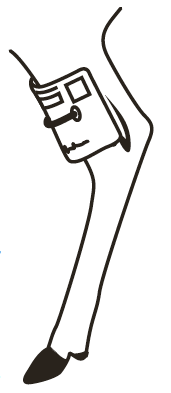
Paper permits and tags purchased through the internet must be printed on a desktop printer at the time of purchase. To protect a non-waterproof paper tag, place it in a clear plastic bag and attach it to the leg of the animal with a zip-tie or other attachment.
The carcass tag must remain attached to the animal during transport and kept with the meat until it is consumed, given to another or otherwise disposed of.
Animals taken with antlerless-only permits must be transported with the head attached to the carcass. However, it is best not to transport carcasses from areas with known cases of chronic wasting disease (CWD) to prevent spreading the disease. An animal taken with an antlerless-only permit may be quartered as long as genitalia is left attached to one of the rear quarters, leaving the spinal column and head at the hunting site. Or an antlerless animal may be boned out at the kill site if it is registered electronically. The voluntary registration process allows hunters to send photos of the animal with the carcass tag attached to KDWPT before boning the meat. A confirmation number will be sent, which will allow transport of the meat. The carcass may be left at the hunting site. To learn more about electronic registration, visitksoutdoors.com/programs, then click "Electronic Deer Check-in."
E-tags: Hunters who choose e-tags will keep the big game permit and e-tag on their mobile device. To validate an e-tag when an animal is killed, open the "HuntFishKS" mobile app and record the date and time of kill and enter a photograph of the entire carcass with sufficient clarity to display the species and whether it is antlered or antlerless. Once the data and photo are submitted, a confirmation number will be displayed within the app must be kept on the mobile device during transport and retained by the hunter until the meat is consumed, given to another or otherwise disposed of. An e-tag confirmation number will work the same as electronic registration for a hunter wanting to bone out an animal taken with an antlerless-only permit and transport only meat.
Survey: Hunters may be requested to complete an online KANSAS DEER HUNTER HARVEST SURVEY at the end of the season. Information received helps biologists make decisions and manage a healthy herd. A random sample of hunters will be contacted after the season, making it important for hunters to update address information each year when they purchase a permit. Hunters surveyed will receive an email or a postcard with a weblink to direct them to a website with the online survey. Questions about this survey or assistance in completing it may be obtained at the KDWPT Research and Survey Office, (620) 342- 0658. State law (K.S.A. 32-937) requires that deer hunters receiving a harvest report card complete the survey.
TICK-BORNE DISEASES
Ticks can carry germs that cause serious and sometimes deadly diseases such as tularemia, ehrlichio-sis, anaplasmosis, Rocky Mountain spotted fever, and Lyme disease. Tick-borne diseases are transmitted to humans when an infected tick bites a human. In Kansas, approximately 300 people are diagnosed with tick-borne diseases every year.
Because ticks live in grassy, brushy, or wooded areas, and on animals, hunters are at an increased risk of contracting
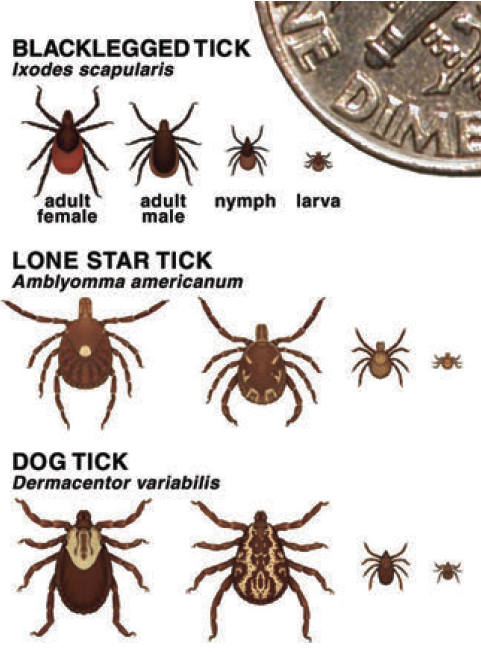
tick-borne diseases.
In Kansas, ticks most likely to cause disease in humans and animals are American dog ticks, Lone Star ticks, and Blacklegged ticks.
Common signs and symptoms following contact with an infected tick include fever, rash, or flu-like illness. Symptoms may not appear for seven to 21 days after a bite. Most tick-borne diseases can be effec-tively treated if recognized early, so hunters should notify their doctor of any recent tick bites or outdoor activities where exposure to ticks may have occurred.
Permetherin-treated clothing and gear is a deterrent to ticks, and remains effective through several washings; Permetherin should not be applied to skin. Insect repellents registered through the Environmental Protection Agency (EPA) containing DEET, picaridin, IR3535, oil of lemon eucalyptus (OLE), paramenthanediol (PMD), or 2-undecanone can effectively repel ticks, and may be applied to skin and clothing. Hunting dogs should also be treated with tick prevention products, as prescribed by a veterinarian.
Before going afield, hunters should tuck pants into socks and shirts into pants to prevent ticks from crawling inside clothing. It is wise to limit walking time on game trails, as ticks target these trails as a way to latch onto their wildlife hosts. Upon returning from the outdoors, hunters should immediately shower to remove any unattached ticks, then perform a body check. Ticks in larvae and nymph stages are harder to see than adult ticks, so thorough careful inspections are needed, especially in the armpits and waste line where belts restrict the upward movement of ticks. Dogs should also be inspected for ticks. Additionally, clothes that have been worn outside when ticks are active should be contained in an air-tight bag until washed, and shoes left outside, to help prevent ticks from entering a house. For a guide on how to perform a tick check, and how to remove ticks, visit https://www.cdc.gov/features/h....
IMPORTANT NOTE REGARDING TULAREMIA:
Most tick-borne diseases are spread through the bite of an infected tick. However, the bacteria that cause tularemia can also be spread through deer flies or contact with infected animals and their carcasses
Hunters should always wear gloves when handling sick or dead animals.
Hunting dogs can also contract tularemia if they've been in contact with infected game. If a hunting dog develops a fever, becomes depressed, or loses its appetite, consult a veterinarian immediately. Tularemia and other diseases have been passed from exposed dogs to humans because of dogs licking their owners' faces.
CHRONIC WASTING DISEASE (CWD)
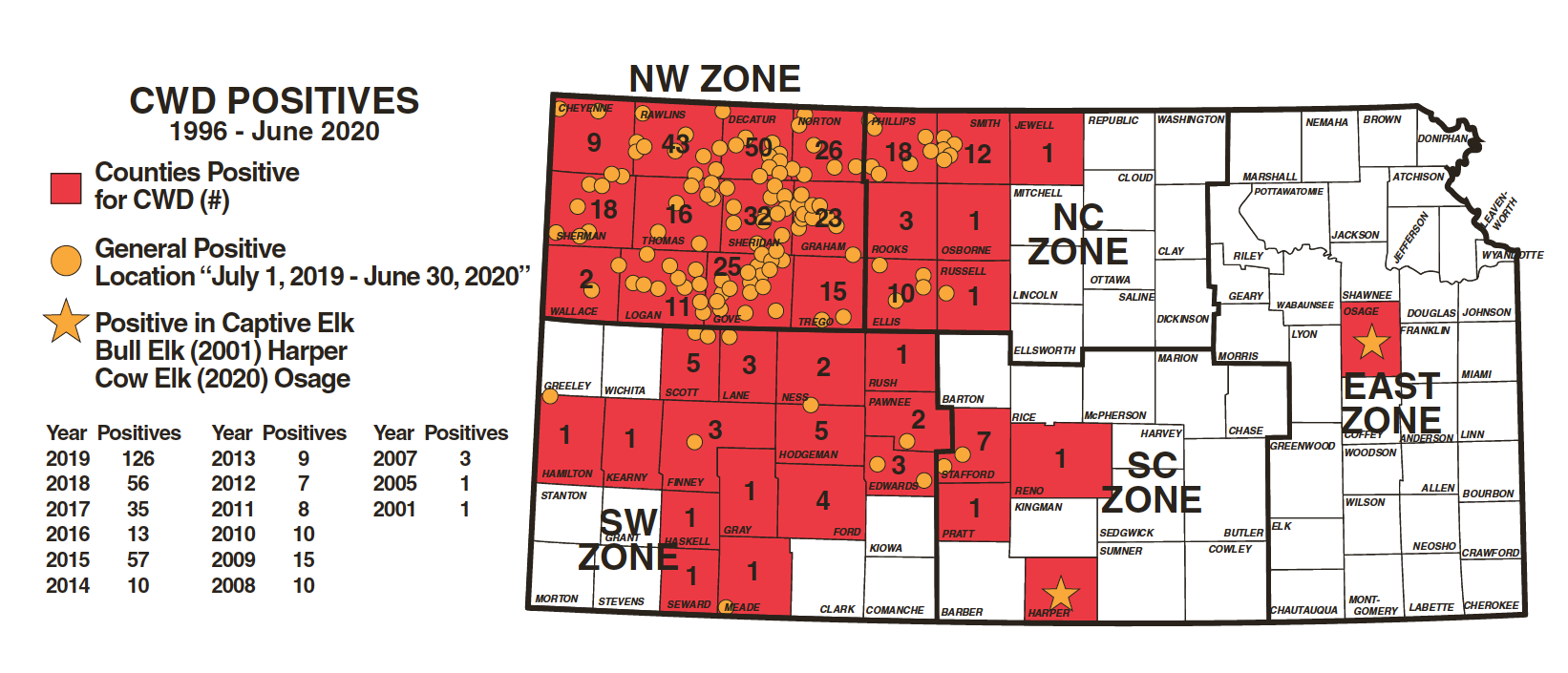
WHAT IS CWD?
Chronic Wasting Disease (CWD) is a contagious, neurological disease of deer, elk, moose and other cervids, caused by the deposition and clumping of abnormal proteins (prions) in the brain that kills neurons, resulting in cytoplasmic vacuolation and a characteristic sponge-like degeneration of the brains of infected animals. Outward symptoms of the disease include emaciation, abnormal behavior, excessive salivation and loss of bodily functions. Predators often see, kill, and eat these vulnerable, symptomatic animals long before they are seen by humans. Many times, CWD-positive deer are observed near outbuildings at farmsteads or near bodies of water. Symptoms don't manifest until the last couple months before the cervid dies; therefore, most CWD-positive cervids are asymptomatic and look normal when they are harvested.
CWD belongs to a group of diseases known as transmissible spongiform encephalopathies (TSEs). Within this family of diseases, there are several other variants that affect domestic animals. Examples of TSEs include: scrapie, which has been identified in domestic sheep and goats for more than 200 years; bovine spongiform encephalopathy (BSE) in cattle (also known as "mad cow" disease); and transmissible mink encephalopathy (TME) in farmed mink.
A human form, Creutzfeldt-Jakob disease (CJD), occurs naturally and spontaneously in about one out of every one million people world-wide. Variant Creutzfeldt-Jakob disease (vCJD) has been associated with consumption of beef from the large-scale outbreak of BSE in cattle herds, starting in the 1980s, in Great Britain and over 220 people contracted vCJD. However, CWD has not been documented to have caused disease in humans to date, but due to the similarities of prions and certain lab experiments, hunters and those eating venison should take certain precautions to avoid exposure to abnormal prions to manage and lower exposure risk.
Impacts of CWD on population dynamics of deer and elk are presently unclear. Population impacts have been documented in mule deer, white-tailed deer and elk in restricted geographic areas, but it is uncertain whether CWD will impact herds on a larger geographic scale. Computer models suggest that CWD could substantially reduce infected cervid populations by lowering adult survival rates and destabilizing longterm population dynamics over the next several decades, resulting in fewer older animals (trophy animals) in the population.
The prion or infectious protein is very stable and resists environmental degradation and becomes more infective after it binds to clay par-ticles in the soil. Cervids are thought to become infected via animal-to-animal contact and indirectly via contaminated environment-to-animal transmission. Baiting, feeding, and artificially concentrating deer is not advised. Infected deer will excrete as many infectious prions throughout the course of its life (urine, feces, saliva, breath, etc.) as will be accumulated in the tissues of the animal at the time of its death.
IS THE MEAT SAFE TO EAT?
At this time, there is no evidence that CWD has been transmitted to humans. Despite our increasing understanding and knowledge of the
disease, there continues to be gaps in our complete understanding of the disease. Due to this uncertainty, its similarity with other known TSEs, and potentially longterm incubation time, hunters should not eat meat from animals known to be infected with CWD or exhibiting signs of any disease. Thoroughly cooking CWD-positive meat does not destroy prions. Prion destruction via heat starts at around 1,000 degrees F for an extended time. Hunters, especially in CWD areas, are advised to bone out their meat to avoid transporting prions to uninfected areas. Prions reside in carcasses, and an infected carcass has the potential to start a new focus of disease in a previously uninfected area. Electronic Deer Check-in is required to leave carcasses in the field that were taken with an antlerless permit. Deer taken with either-sex permits can be boned out in the field, leaving the carcass in the field, without using Electronic Deer Check-in. Each hunter must make the decision whether to consume wildlife or deer that test positive for CWD. KDWPT does not recommend eating wildlife that are sick or diseased. Here are bullet points from the Centers for Disease Control and Prevention regarding CWD precautions:
To minimize their risk of exposure to CWD, hunters should:
- Do not shoot, handle or eat meat from deer and elk that look sick or are acting strangely or are found dead.
- When field-dressing a deer: Wear latex or rubber gloves when dressing the animal or handling the meat. Minimize how much you handle the organs of the animal, particularly the brain or spinal cord tissues. Do not use household knives or other kitchen utensils for field dressing.
- Check state wildlife and public health guidance to see whether testing of animals is recommended or required. Recommendations vary by state, but information about testing is available from many state wildlife agencies.
- Consider having the deer or elk tested for CWD before you eat the meat.
- If you have your deer or elk commercially processed, consider asking that your animal be processed individually to avoid mixing meat from multiple animals.
- If your animal tests positive for CWD, do not eat meat from that animal.
DEER HARVESTED OUTSIDE THE SOUTHCENTRAL (SC) ZONE CAN BE TESTED FOR FREE THROUGH THE UNIVERSITY OF MISSOURI CWD STUDY.
CWD testing is not a food safety test. Testing is done to measure herd health, and all samples may not be tested if the target numbers of sam-ples have been obtained. Hunters will be notified by phone if their sample tests positive for CWD. It typically takes about 1-1.5 weeks to get a result once the sample arrives at KSVDL. Samples submitted through the University of Missouri are no cost to the hunter for testing but turnaround time for results is closer to 2-4 weeks. Keep in mind that when animals submit-ted to taxidermists may not immediately be sent out for testing but rather are sent to the lab in bulk a few times throughout the season.
Southcentral Zone samples will only be picked up from the sample collectors and delivered to KSVDL 2-3 times during the 2022-2023 deer seasons. If KDWP Southcentral Zone sample sizes are adequate, the Missouri CWD Study may start collecting and testing samples from the Southcentral Zone. Hunters have the option of freezing their venison until a result is obtained.(Freezing meat for 30 days is recommended before making jerky because this will help kill parasites present in the meat. Jerky is made at lower-than-normal cooking temperatures.) Hunters wanting a quicker result can submit samples privately by calling KSVDL Client Care at 785-532-5650. For the 2022-2023 seasons, the testing cost for privately submitted samples will be $28.. KSVDL provides test kits for $6.50, and shipping back to the lab is $7.50. If a deer head is submitted to KSVDL, there is a $16 fee for KSVDL to sample the head and a head dis-posal fee of $15.50.
2022-2023 SAMPLE COLLECTORS AVAILABLE TO ASSIST WITH SAMPLING DEER IN THE SOUTHCENTRAL "SC ZONE":
Sample collector contact information will be posted at https://ksoutdoors.com/Hunting... in the coming months.
FREE CWD TESTING FOR DEER HARVESTED OUTSIDE OF THE SOUTHCENTRAL "SC ZONE":
- Call or text 620-402-4195 or email kscwdsurveillance@gmail.com for more information.
- Hunters are invited to submit samples through participating KDWP offices, participating taxidermists/meat processors, or by submitting inde-pendently directly to the lab.
- Watch this video to learn how to sample a deer for CWD testing. https://www.youtube.com/watch?....
- Make sure to write down/remember the data card barcode number or the temporary Tyvek tag number of the sample when having your deer/elk sampled for CWD. The barcode number or Tyvek tag number are the numbers used when your result is posted on the website.
- Hunters will be notified by phone call if a deer they harvest tests positive.
- All CWD test results will be posted at ksoutdoors.com/Hunting/Big-Game-Information/Chronic-Wasting-Disease-CWD/2022-2023-CWD-Testing-Results.
NEW CHRONIC WASTING DISEASE RESEARCH PROJECT
KDWPT is requesting hunter assistance with a new three-year research project to better understand how different habitats affect the spread of Chronic Wasting Disease within your Kansas deer herd. Chronic Wasting Disease, if left unchecked, negatively affects deer populations by changing age structure and decreasing resilience, which can result in a deer herd that cannot maintain or grow in population size and has fewer mature individuals.
How can hunters help? Six different deer management units (DMUs) will be sampled each year of the project. Hunters who harvest a deer within one of the DMUs being sampled can submit a Chronic Wasting Disease sample to KDWPT for testing. Samples need to be accompanied by sex, age, and location information. To evaluate how habitat affects CWD in the deer herd, location information must allow for the identification of the section where the deer was harvested, such as GPS coordinates or section-township-range number. If you would like to know if your deer tests positive for CWD, include your name and phone number or KDWPT number. Testing of samples submitted for the research project will be completed at no cost to the hunter. Hunters harvesting multiple deer may submit multiple samples. Note: After caping is completed, samples can be collected from a deer that will be taxidermy mounted without affecting the mount; check with your taxidermist for specifics.
A map to assist you with section-township-range location information and a video showing how to collect the lymph node tissue sample for chronic wasting disease testing can be found at: ksoutdoors.com/Hunting/Big-Game-Information/Chronic-Wasting-Disease.
The map is also available in the ArcGIS Explorer App, simply search for "Kansas CWD Sampling Map" in the app.
For more information about this research project, visit ksoutdoors.com/cwd.
In partnership with:
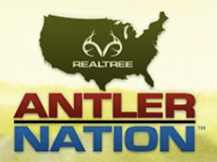
Source: https://www.eregulations.com/kansas/hunting/deer-hunting-regulations
0 Response to "Legal for Feed Deer in Kansas"
Post a Comment